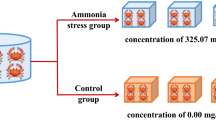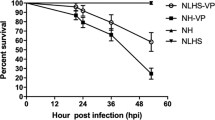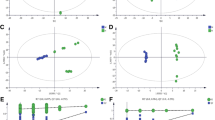Abstract
Bivalve mass mortalities have been reported worldwide, which not only can be explained as a result of pathogen infection, but may reflect changes in environments. Although these episodes were often reported, there was limited information concerning the molecular responses to various stressors leading to summer mortality. In the present work, RNA sequencing (RNA-seq), tandem mass tagging (TMT)-based quantitative proteomics, and 16S rRNA sequencing were used to explore the natural outbreak of summer mortality in the clam Meretrix petechialis. We identified a total of 172 differentially expressed genes (DEGs) and 222 differentially expressed proteins (DEPs) in the diseased group compared to the normal group. The inconsistent expression profiles of immune DEGs/DEPs may be due to the immune dysregulation of the diseased clams. Notably, 11 solute carrier family genes were found among the top 20 down-regulated genes in the diseased group, indicating that weakened transmembrane transport ability might occur in the diseased clams. Integration analysis of transcriptomic and proteomic results showed that many metabolic processes such as “arginine and proline metabolism” and “tyrosine metabolism” were inhibited in the diseased group, suggesting metabolic inhibition. Moreover, 16S rRNA sequencing revealed that the microbial composition of clam hepatopancreas was disordered in the diseased group. The comparison of DEGs expression between the natural summer mortality event and an artificial challenge experiment involving both Vibrio infection and heat stress revealed 9/15 genes showing similar expression trends between the two conditions, suggesting that the summer mortality might be caused by a combination of high temperature and Vibrio infection. These results would deepen our understanding of summer mortality and provide candidate resistance markers for clam resistance breeding.








Similar content being viewed by others
Data Availability
The transcriptome datasets in this study have been submitted to the Sequence Read Archive (SRA) of the National Center for Biotechnology Information with the BioProject accession number PRJNA1025978. The mass spectrometry proteomics data have been deposited to the ProteomeXchange Consortium (http://proteomecentral.proteomexchange.org) via the iProX partner repository with the dataset identifier PXD046074.
References
Alfaro AC, Nguyen TV, Merien F (2019) The complex interactions of Ostreid herpesvirus 1, Vibrio bacteria, environment and host factors in mass mortality outbreaks of Crassostrea gigas. Rev Aquac 11:1148–1168
Barbosa Solomieu V, Renault T, Travers MA (2015) Mass mortality in bivalves and the intricate case of the Pacific oyster, Crassostrea gigas. J Invertebr Pathol 131:2–10
Burdon D, Callaway R, Elliott M, Smith T, Wither A (2014) Mass mortalities in bivalve populations: a review of the edible cockle Cerastoderma edule (L.). Estuar Coast Shelf Sci 150:271–280
Burge CA, Griffin FJ, Friedman CS (2006) Mortality and herpesvirus infections of the Pacific oyster Crassostrea gigas in Tomales Bay, California, USA. Dis Aquat Org 72:31–43
Burzle M, Suzuki Y, Ackermann D, Miyazaki H, Maeda N, Clemencon B, Burrier R, Hediger MA (2013) The sodium-dependent ascorbic acid transporter family SLC23. Mol Aspects Med 34:436–454
Chen YG, Yuan K, Zhang ZZ, Yuan FH, Weng SP, Yue HT, He JG, Chen YH (2016) Identification and functional characterization of a solute carrier family 15, member 4 gene in Litopenaeus vannamei. Dev Comp Immunol 57:57–66
Clegg TA, Morrissey T, Geoghegan F, Martin SW, Lyons K, Ashe S, More SJ (2014) Risk factors associated with increased mortality of farmed Pacific oysters in Ireland during 2011. Prev Vet Med 113:257–267
De Lorgeril J, Lucasson A, Petton B, Toulza E, Montagnani C, Clerissi C, Vidal-Dupiol J, Chaparro C, Galinier R, Escoubas JM, Haffner P, Degremont L, Charriere GM, Lafont M, Delort A, Vergnes A, Chiarello M, Faury N, Rubio T, Leroy MA, Perignon A, Regler D, Morga B, Alunno-Bruscia M, Boudry P, Le Roux F, Destoumieux-Garzomicronn D, Gueguen Y, Mitta G (2018) Immune-suppression by OsHV-1 viral infection causes fatal bacteraemia in Pacific oysters. Nat Commun 9:4215
Degremont L, Ernande B, Bédier E, Boudry P (2007) Summer mortality of hatchery-produced Pacific oyster spat (Crassostrea gigas). I. Estimation of genetic parameters for survival and growth. Aquaculture 262:41–53
Edgar RC (2013) UPARSE: highly accurate OTU sequences from microbial amplicon reads. Nat Methods 10:996–998
Fabioux C, Huvet A, Lelong C, Robert R, Pouvreau S, Daniel JY, Minguant C, Le Pennec M (2004) Oyster vasa-like gene as a marker of the germline cell development in Crassostrea gigas. Biochem Bioph Res Co 320:592–598
Go J, Deutscher AT, Spiers ZB, Dahle K, Kirkland PD, Jenkins C (2017) Mass mortalities of unknown aetiology in Pacific oysters Crassostrea gigas in Port Stephens, New South Wales, Australia. Dis Aquat Org 125:227–242
Grabherr MG, Haas BJ, Yassour M, Levin JZ, Thompson DA, Amit I, Adiconis X, Fan L, Raychowdhury R, Zeng QD, Chen ZH, Mauceli E, Hacohen N, Gnirke A, Rhind N, Di Palma F, Birren BW, Nusbaum C, Lindblad-Toh K, Friedman N, Regev A (2011) Full-length transcriptome assembly from RNA-Seq data without a reference genome. Nat Biotechnol 29:644-U130
Harris ED (2000) Cellular copper transport and metabolism. Annu Rev Nutr 20:291–310
He Y, Li X, Shi C, Li Y, Li Q, Liu S (2022) Transcriptome profiling of the Pacific oyster (Crassostrea gigas) suggests distinct host immune strategy in response to Vibrio alginolyticus infection. Aquaculture 560:738563
Hine PM, Wesney B, Hay BE (1992) Herpesviruses associated with mortalities among hatchery-reared larval Pacific oysters Crassostrea-Gigas. Dis Aquat Org 12:135–142
Ivanina AV, Dickinson GH, Matoo OB, Bagwe R, Dickinson A, Beniash E, Sokolova IM (2013) Interactive effects of elevated temperature and CO2 levels on energy metabolism and biomineralization of marine bivalves Crassostrea virginica and Mercenaria mercenaria. Comp Biochem Phys A 166:101–111
Jiang FJ, Yue X, Wang HX, Liu BZ (2017) Transcriptome profiles of the clam Meretrix petechialis hepatopancreas in response to Vibrio infection. Fish Shellfish Immun 62:175–183
Jiang LL, Hong YJ, Xie GS, Zhang JH, Zhang HN, Cai ZW (2021) Comprehensive multi-omics approaches reveal the hepatotoxic mechanism of perfluorohexanoic acid (PFHxA) in mice. Sci Total Environ 790:148160
Lattos A, Giantsis IA, Karagiannis D, Theodorou JA, Michaelidis B (2020) Gut symbiotic microbial communities in the IUCN critically endangered Pinna nobilis suffering from mass mortalities, revealed by 16S rRNA amplicon NGS. Pathogens 9:1002
Le Roux F, Gay M, Lambert C, Waechter M, Poubalanne S, Chollet B, Nicolas JL, Berthe F (2002) Comparative analysis of Vibrio splendidus-related strains isolated during Crassostrea gigas mortality events. Aquat Living Resour 15:251–258
Li YF, Yang N, Liang X, Yoshida A, Osatomi K, Power D, Batista FM, Yang JL (2018) Elevated seawater temperatures decrease microbial diversity in the gut of Mytilus coruscus. Front Physiol 9:839
Li SM, Alfaro AC, Nguyen TV, Young T, Lulijwa R (2020) An integrated omics approach to investigate summer mortality of New Zealand greenshell (TM) mussels. Metabolomics 16:100
Liang BB, Jiang FJ, Zhang SJ, Yue X, Wang HX, Liu BZ (2017) Genetic variation in vibrio resistance in the clam Meretrix petechialis under the challenge of Vibrio parahaemolyticus. Aquaculture 468:458–463
Liang ZW, Yang LW, Zheng JF, Zuo HL, Weng SP, He JG, Xu XP (2019) A low-density lipoprotein receptor (LDLR) class A domain-containing C-type lectin from Litopenaeus vannamei plays opposite roles in antibacterial and antiviral responses. Dev Comp Immunol 92:29–34
Liu BZ, Dong B, Tang BJ, Zhang T, Xiang JJ (2006) Effect of stocking density on growth, settlement and survival of clam larvae, Meretrix meretrix. Aquaculture 258:344–349
Liu H, Zha S, Yang Z, Zhang W, Lin Z, Wang S, Bao Y (2022) Acute sulfide exposure induces hemocyte toxicity and microbiota dysbiosis in blood clam Tegillarca granosa. Aquat Toxicol 249:106224
Livak KJ, Schmittgen TD (2001) Analysis of relative gene expression data using real-time quantitative PCR and the 2(T) (-Delta Delta C) method. Methods 25:402–408
Lv Z, Qiu L, Wang M, Jia Z, Wang W, Xin L, Liu Z, Wang L, Song L (2018) Comparative study of three C1q domain containing proteins from pacific oyster Crassostrea gigas. Dev Comp Immunol 78:42–51
Ma S, Shu X, Wang WX (2022) Multi-omics reveals the regulatory mechanisms of zinc exposure on the intestine-liver axis of golden pompano Trachinotus ovatus. Sci Total Environ 816:151497
Magoc T, Salzberg SL (2011) FLASH: fast length adjustment of short reads to improve genome assemblies. Bioinformatics 27:2957–2963
Malik AR, Willnow TE (2019). Excitatory amino acid transporters in physiology and disorders of the central nervous system. Int J Mol Sci, 20.
Monari M, Matozzo V, Foschi J, Cattani O, Serrazanetti GP, Marin MG (2007) Effects of high temperatures on functional responses of haemocytes in the clam Chamelea gallina. Fish Shellfish Immun 22:98–114
Nguyen TV, Alfaro AC, Merien F (2019) Omics approaches to investigate host-pathogen interactions in mass mortality outbreaks of Crassostrea gigas. Rev Aquac 11:1308–1324
Nie Q, Yue X, Liu BZ (2015) Development of Vibrio spp. infection resistance related SNP markers using multiplex SNaPshot genotyping method in the clam Meretrix meretrix. Fish Shellfish Immun 43:469–476
Ortega L, Celentano E, Delgado E, Defeo O (2016) Climate change influences on abundance, individual size and body abnormalities in a sandy beach clam. Mar Ecol Prog Ser 545:203–213
Petton B, Pernet F, Robert R, Boudry P (2013) Temperature influence on pathogen transmission and subsequent mortalities in juvenile Pacific oysters Crassostrea gigas. Aquacult Env Interac 3:257–273
Pizzagalli MD, Bensimon A, Superti-Furga G (2021) A guide to plasma membrane solute carrier proteins. Febs J 288:2784–2835
Rubiolo JA, Lozano-Leon A, Rodriguez-Souto R, Rodriguez NF, Vieytes MR, Botana LM (2018) The impact of depuration on mussel hepatopancreas bacteriome composition and predicted metagenome. Anton Leeuw Int J G 111:1117–1129
Saco A, Rey-Campos M, Novoa B, Figueras A (2020) Transcriptomic response of mussel gills after a Vibrio splendidus infection demonstrates their role in the immune response. Front Immunol 11:615580
Saco A, Panebianco A, Blanco S, Novoa B, Diz AP, Figueras A (2021) Integration of transcriptomics and proteomics improves the characterization of the role of mussel gills in a bacterial waterborne infection. Front Mar Sci 8:735309
Segarra A, Pepin JF, Arzul I, Morga B, Faury N, Renault T (2010) Detection and description of a particular Ostreid herpesvirus 1 genotype associated with massive mortality outbreaks of Pacific oysters, Crassostrea gigas, in France in 2008. Virus Res 153:92–99
Solomieu VB, Renault T, Travers MA (2015) Mass mortality in bivalves and the intricate case of the Pacific oyster, Crassostrea gigas. J Invertebr Pathol 131:2–10
Soon TK, Ransangan J (2019) Extrinsic factors and marine bivalve mass mortalities: an overview. J Shellfish Res 38:223–232
Soon TK, Zheng HP (2020) Climate change and bivalve mass mortality in temperate regions. Rev Environ Contam T 251:109–129
Soon TK, Denil DJ, Ransangan J (2016) High mortality and poor growth of green mussels, Perna viridis, in high chlorophyll-a environment. Ocean Sci J 51:43–57
Stojanov S, Berlec A, Štrukelj B (2020) The influence of probiotics on the Firmicutes/Bacteroidetes ratio in the treatment of obesity and inflammatory bowel disease. Microorganisms 8:1715
Talmage SC, Gobler CJ (2011) Effects of elevated temperature and carbon dioxide on the growth and survival of larvae and juveniles of three species of Northwest Atlantic bivalves. PLoS ONE 6:e26941
Tan KS, Ransangan J (2015) Factors influencing the toxicity, detoxification and biotransformation of paralytic shellfish toxins. Rev Environ Contam Toxicol 235:1–25
Tian J, Li YJ, Fu HR, Ren LT, He YM, Zhai SY, Yang B, Li Q, Liu NN, Liu SK (2021) Physiological role of CYP17A1-like in cadmium detoxification and its transcriptional regulation in the Pacific oyster, Crassostrea gigas. Sci Total Environ 796:149039
Travers MA, Boettcher Miller K, Roque A, Friedman CS (2015) Bacterial diseases in marine bivalves. J Invertebr Pathol 131:11–31
Vaughn CC, Hoellein TJ (2018) Bivalve impacts in freshwater and marine ecosystems. Annu Rev Ecol Evol S 49:183–208
Vezzulli L, Previati M, Pruzzo C, Marchese A, Bourne DG, Cerrano C, Consortium V (2010) Vibrio infections triggering mass mortality events in a warming Mediterranean Sea. Environ Microbiol 12:2007–2019
Villalba A, Carballal MJ, Lopez C, Cabada A, Corral L, Azevedo C (1999) Branchial rickettsia-like infection associated with clam Venerupis rhomboides mortality. Dis Aquat Org 36:53–60
Wang H, Yue X, Yu J, Wang R, Teng S, Fang J, Liu B (2020) Microbial community changes in the digestive tract of the clam Meretrix petechialis in response to Vibrio parahaemolyticus challenge. Journal of Oceanology and Limnology 39:329–339
Xiao H, Ford SE, Yang HS, Zhang GF, Zhang FS, Guo XM (2005) Studies on mass summer mortality of cultured zhikong scallops (Chlamys farreri Jones et Preston) in China. Aquaculture 250:602–615
Xun XG, Cheng J, Wang J, Li YP, Li X, Li ML, Lou JR, Kong YF, Bao ZM, Hu XL (2020) Solute carriers in scallop genome: gene expansion and expression regulation after exposure to toxic dinoflagellate. Chemosphere 241:124968
Yang B, Zhai SY, Li X, Tian J, Li Q, Shan HW, Liu SK (2021) Identification of Vibrio alginolyticus as a causative pathogen associated with mass summer mortality of the Pacific oyster (Crassostrea gigas) in China. Aquaculture 535:736363
Young MD, Wakefield MJ, Smyth GK, Oshlack A (2010) Gene ontology analysis for RNA-seq: accounting for selection bias. Genome Biol 11:R14
Yue X, Liu BZ, Xiang JH, Jia JT (2010) Identification and characterization of the pathogenic effect of a Vibrio parahaemolyticus-related bacterium isolated from clam Meretrix meretrix with mass mortality. J Invertebr Pathol 103:109–115
Yue X, Huan P, Hu YH, Liu BZ (2018) Integrated transcriptomic and proteomic analyses reveal potential mechanisms linking thermal stress and depressed disease resistance in the turbot Scophthalmus maximus. Sci Rep-Uk 8:1896
Zannella C, Mosca F, Mariani F, Franci G, Folliero V, Galdiero M, Tiscar PG, Galdiero M (2017) Microbial diseases of bivalve mollusks: infections, immunology and antimicrobial defense. Mar Drugs 15:182
Zhang SJ, Yue X, Jiang FJ, Wang HX, Liu BZ (2017) Identification of an MITF gene and its polymorphisms associated with the Vibrio resistance trait in the clam Meretrix petechialis. Fish Shellfish Immun 68:466–473
Zhang S, Yue X, Yu J, Wang H, Liu B (2019) MITF regulates downstream genes in response to Vibrio parahaemolyticus infection in the clam Meretrix Petechialis. Front Immunol 10:1547
Zou LH, Liu BZ (2016) The polymorphisms of a MIF gene and their association with Vibrio resistance in the clam Meretrix meretrix. Dev Comp Immunol 62:116–126
Funding
This research was supported by the Strategic Priority Research Program of the Chinese Academy of Sciences (XDA24030304), the Key Research and Development Program of Shandong (2021LZGC029), the earmarked fund for CARS-49, and the Taishan Industrial Leading Talents Project to Shandong Dehe Mingxing Biotechnology Co., Ltd. Chinese Academy of Sciences,XDA24030304,XDA24030304.
Author information
Authors and Affiliations
Contributions
Jing Tian, Hongxia Wang, and Xin Yue performed the experiment. Jing Tian analyzed the data and drafted the manuscript. Pin Huan and Baozhong Liu revised the manuscript. Baozhong Liu conceived the study and obtained the funding. All authors reviewed and approved the manuscript.
Corresponding author
Ethics declarations
Ethics Approval
The clams are neither an endangered nor protected species. All experiments in this study were conducted according to national and institutional guidelines.
Competing Interests
The authors declare no competing interests.
Additional information
Publisher's Note
Springer Nature remains neutral with regard to jurisdictional claims in published maps and institutional affiliations.
Supplementary Information
Below is the link to the electronic supplementary material.
Rights and permissions
Springer Nature or its licensor (e.g. a society or other partner) holds exclusive rights to this article under a publishing agreement with the author(s) or other rightsholder(s); author self-archiving of the accepted manuscript version of this article is solely governed by the terms of such publishing agreement and applicable law.
About this article
Cite this article
Tian, J., Wang, H., Huan, P. et al. Comprehensive Multi-omics Approaches Provide Insights to Summer Mortality in the Clam Meretrix petechialis. Mar Biotechnol 26, 389–403 (2024). https://doi.org/10.1007/s10126-024-10304-0
Received:
Accepted:
Published:
Issue Date:
DOI: https://doi.org/10.1007/s10126-024-10304-0




